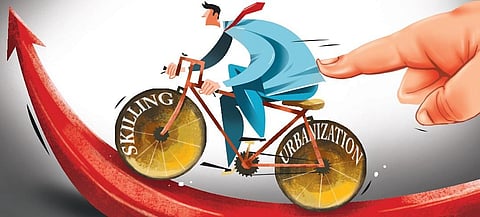

The much-anticipated event everybody was waiting was has been flagged. The United Nations Population Fund (UNFPA) has confirmed that India is now the most populous nation with 142.86 crore people, outstripping China at 142.57 crore. The gap is expected to further widen with the UN projecting India touching 166.8 crores by 2050 while China by then would have declined to 131.7 crore.
The funny thing is no one knows how to react. Is going ahead of China on population something to celebrate about? Or, is it going to be a dubious liability for the future... something we should gulp down… and well, stay silent?
India and the rest of the developed world are in different population cycles. India will continue to grow till about 2050, after which absolute numbers will begin to decline. For the rest of the world, total population touched 8 billion last November. After 1968 the global population growth rate started a long decline with the fertility rate dropping more than half to 2.4 in 2019.
The shrinkage has been the maximum for Europe and Japan – the developed world – geographies that are seeing a 7% fall in population. Interestingly, it will be now migration from war and conflict and human disaster which will add to their population numbers.
The ‘youth’ asset
Back to India. As the most populous nation, how do we see ourselves today? Thinking has changed from the 1980s where family planning and the ‘hum-do-hamare-do’ campaign was a desperate bid to rein in numbers. We are now past the ‘population bomb’. Fertility in India has fallen due a variety of factors, and is nosing down to about 2.0 a family. The new word is ‘demographic dividend’.
For India, population is an asset as nearly half – about 650 million – is below the age of 25. As per ‘Worldometer’ the median age in India is 28.4 years, compared to 38.3 years in the US, 38.4 years in China, and 40.5 years in the UK.Unlike much of the developed world, which has an ageing population that needs looking after, India’s young population is a huge asset that not only provides skills but also drives consumption – the two pillars of economic growth.
But to catch the window of opportunity and cash in on it’s ‘demographic dividend’, India has to focus on planned urbanization, and institutional skilling. With development comes urbanization. It calls for an educated work force and in turn provides citizens with better incomes and a higher quality of life. For all the romance of rural life, India’s semi-feudal village existence can be summed up in Thomas Hobbes’ words: solitary, poor, nasty, brutish and short. Urban life, in contrast, spells rapid cultural and economic progress. India has been slow in the rural-to-urban metamorphosis, but it is happening.
According to new McKinsey Global Institute (MGI) research, 590 million Indians will live in cities by 2030, more than double the 290 million in 2001.The MGI report says India will have 68 cities with populations of over 1 million, and 6 megacities with populations of 10 million or more. This urban explosion will result in surging incomes and consumption. Households with true discretionary spending power could rise sevenfold from 13 million in 2005 to around 90 million in 2025.
Skilling our assets
But these cities have to be planned or else they will be hovels of misery. Billions have to be poured in to provide infrastructure – housing, transportation, education. Despite all the promises of ‘Housing for All by 2022’ and the creation of ‘Smart Cities’ – our urban agglomerations are a commuter’s nightmare and civic failures on most fronts.
Meanwhile, skilling the youth is the crucial link for creating aworkforce that becomes a magnet for investment and development. India has among the largest internet penetrations and a high level of literacy. But on the ground, institutional skilling remains a mirage. Industrial parks, the centers of employment and manufacture in China, have largely evaded India.
The Centre for Monitoring Indian Economy (CMIE) has repeatedly flagged concern that the labour participation, particularly of young people, has been falling and is now just about 40% from 47% in fiscal 2021. It means those of working age, after not finding suitable jobs, simply disappeared from the job market.
From the time ‘liberalization’ kicked in in 1992 there has been talk of creating a ‘safety net’ through retraining and skilling. It has remainedlip service. Only 5 per cent of India’s workforce is formally skilled today, says the World Economic Forum.
More opportunities and skills to make them future-ready, is the need of the hour. There’s another stumbling block. Grinding inequality. With 10% of the creme de la creme holding 73% of the nation’s wealth, while the bottom 50% have access to just 6% of wealth generated, leaves us with a rather constricted growth story.
We also have to consider that the ‘demographic dividend’ window won’t be open forever. India’s population is expected to start declining by 2045 and will perhaps fall to 1 billion people by 2100. The time to cash in on the power and skills of our youth is now.